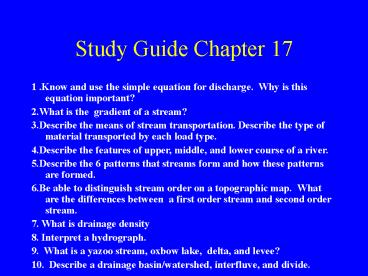Study Guide Chapter 17 - PowerPoint PPT Presentation
1 / 13
Title:
Study Guide Chapter 17
Description:
Study Guide Chapter 17 1 .Know and use the simple equation for discharge. Why is this equation important? 2.What is the gradient of a stream? 3.Describe the means of ... – PowerPoint PPT presentation
Number of Views:74
Avg rating:3.0/5.0
Title: Study Guide Chapter 17
1
Study Guide Chapter 17
1 .Know and use the simple equation for
discharge. Why is this equation
important? 2.What is the gradient of a
stream? 3.Describe the means of stream
transportation. Describe the type of material
transported by each load type. 4.Describe the
features of upper, middle, and lower course of a
river. 5.Describe the 6 patterns that streams
form and how these patterns are formed. 6.Be able
to distinguish stream order on a topographic map.
What are the differences between a first order
stream and second order stream. 7. What is
drainage density 8. Interpret a hydrograph. 9.
What is a yazoo stream, oxbow lake, delta, and
levee? 10. Describe a drainage basin/watershed,
interfluve, and divide.
2
Fluvial Processes and Landforms
- Stream is a general term for water in a channel.
We call a large stream a river. - Fluvial processes are any work done by a stream.
- Gradient of stream is the vertical drop.
3
(No Transcript)
4
Stream flow
- Discharge- The amount of water passing a
particular point per unit time. - Q AXV where Q is discharge in ft3/sec CFS (cubic
feet per second) , A is the cross sectional area
of the stream ft2, and V is the velocity of the
stream ft/sec - A width (ft. ) X depth of stream (ft.)
- Gauging stations (Fig. 17.6) maintained by
Department of Public Works or USGS.
5
(No Transcript)
6
Stream Transportation
- Upper course
- More gradient and more energy
- V shaped valleys formed from erosion (Fig. 17.20)
- Middle Course
- Meandering of stream
- Reduced gradient/decreased energy
- Lower Course
- Vast floodplain.
- Yazoo stream, oxbow lake, delta, Levee
7
(No Transcript)
8
Upper Course
9
(No Transcript)
10
(No Transcript)
11
Fig. 17-7, p. 476
12
Stream ordering
Fig. 17-5, p. 475
13
Drainage Patterns
Fig. 17-8, p. 477










![[PDF] Pharmacology for Nurses Simplified: An Easy to Read Drug Guide Organized by Body Systems, Diseases, and Drug Class - With Downloadable Study Guide Inside (Ninja Series) Ipad PowerPoint PPT Presentation](https://s3.amazonaws.com/images.powershow.com/10085894.th0.jpg?_=20240725116)
![READ [PDF] The Crucible SparkNotes Literature Guide (Volume PowerPoint PPT Presentation](https://s3.amazonaws.com/images.powershow.com/10094115.th0.jpg?_=20240808082)
![[PDF] Study Guide and Procedure Checklist Manual for Kinn's The Clinical Medical Ipad PowerPoint PPT Presentation](https://s3.amazonaws.com/images.powershow.com/10101145.th0.jpg?_=20240816098)

![[PDF] Study Guide for Fundamentals of Nursing Free PowerPoint PPT Presentation](https://s3.amazonaws.com/images.powershow.com/10101152.th0.jpg?_=202408160910)







![[PDF] Study Guide for Medical-Surgical Nursing: Concepts for Interprofessional Collaborative Care 10th Edition Full PowerPoint PPT Presentation](https://s3.amazonaws.com/images.powershow.com/10101179.th0.jpg?_=20240816105)

![[PDF] Study Guide for Pharmacology: A Patient-Centered Nursing Process Approach Kindle PowerPoint PPT Presentation](https://s3.amazonaws.com/images.powershow.com/10101186.th0.jpg?_=20240816108)
![[PDF] Study Guide for the Core Curriculum for Oncology Nursing Free PowerPoint PPT Presentation](https://s3.amazonaws.com/images.powershow.com/10101188.th0.jpg?_=20240816109)



![[PDF] Study Guide for Wong's Essentials of Pediatric Nursing 11th Edition Free PowerPoint PPT Presentation](https://s3.amazonaws.com/images.powershow.com/10101197.th0.jpg?_=20241106066)

